Hell And Back
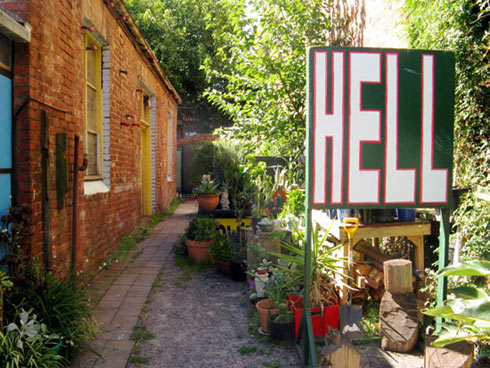
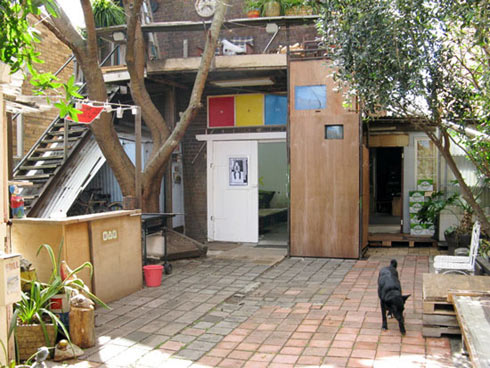
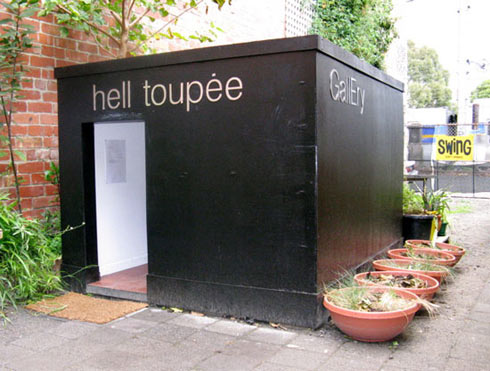
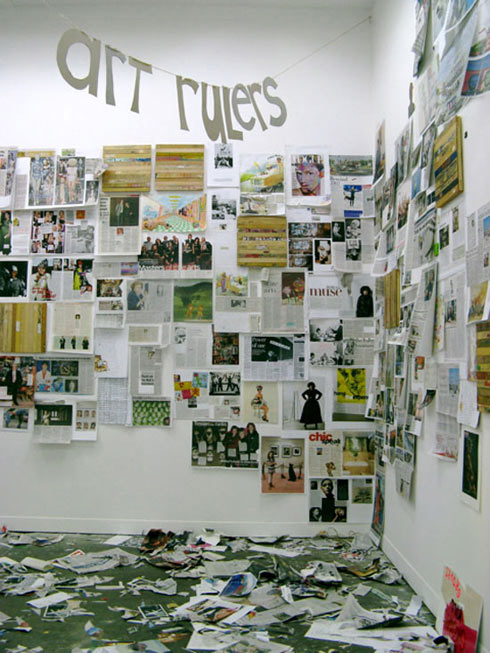
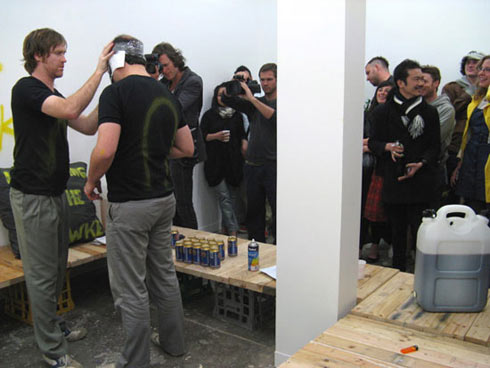
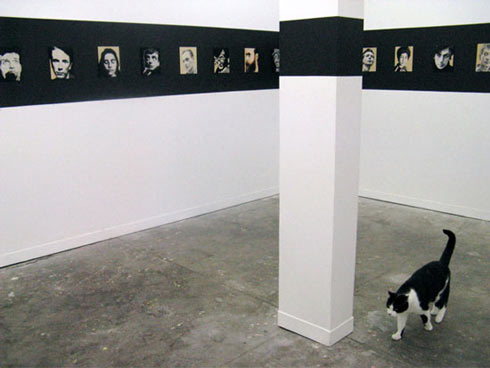
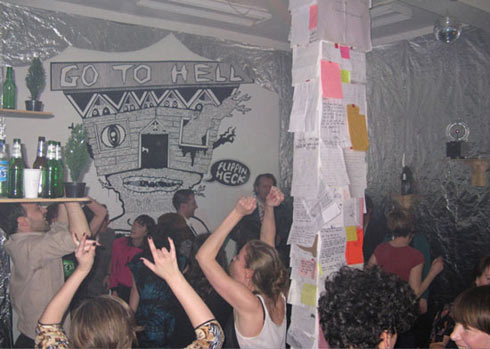
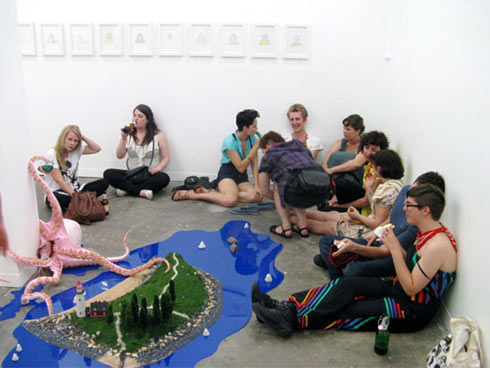
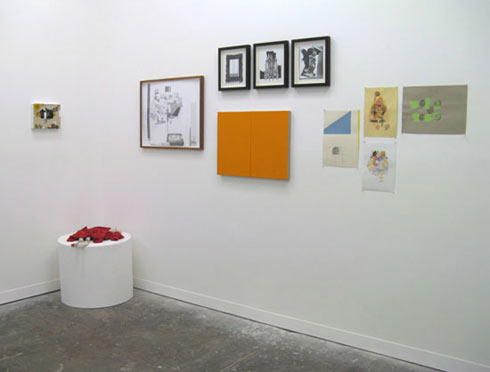
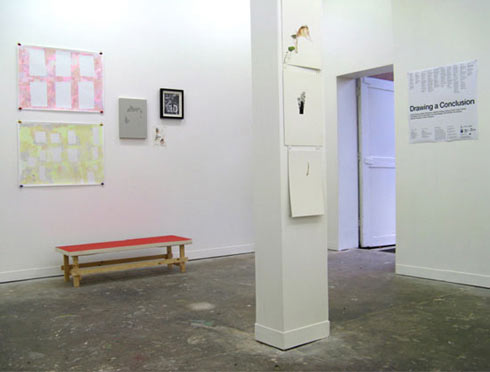 Text: Melissa Loughnan Images: Hell Gallery
Text: Melissa Loughnan Images: Hell Gallery
Hell Gallery was founded by artists Jess Johnson and Jordan Marani in February 2008. The artists built the gallery at the ground floor of their home, from waste materials collected from various art institutions through their roles as installation technicians. Hell consists of Hell Gallery, Hell Toupee (the miniature gallery built in its pathway), studios, a project room, a performance stage, outdoor TV’s, a bar and BBQ, all within a garden courtyard setting. The gallery has been producing a strong program of exhibitions since its inception, and was recently invited to take part in the Tate Modern’s No Soul for Sale festival. Melissa Loughnan catches up with Jess Johnson to find out more.
Melissa Loughnan: What motivated you both to start Hell Gallery, and what keeps you motivated to continue running the space?
Jess Johnson: At the time we were motivated by a void we perceived in the gallery scene. After being involved in ARI boards I felt strongly about certain things; accepted procedures that I saw as flaws in their models. Jordy and I also felt that everything seemed a bit uptight. There was this air of stagnant professionalism across the art scene and we felt it was the right time to try and loosen things up.
The traditional ARI will rent a space and set up a board of like-minded artistic types to administer it. They will solicit exhibitions and charge the exhibiting artist a fee to exhibit. This subsidises the rental of the space. I don’t think this works particularly well. The rent-a-space model creates this factory line of recent graduates putting themselves in debt to exhibit. It excludes artists who can’t afford the fees. It also excludes those who haven’t gone to the right art school or who aren’t any good at writing proposals or who aren’t part of the right scene. That’s a lot of exclusion.
There’s so much money and logistics involved with renting a space and keeping it open during the week. I think that making the artist pay exhibiting fees contributes to a faulty model. Rent-a-space galleries may have to accept exhibitions that aren’t necessarily very good, just to have the rent paid. That’s not fair on anyone. Often it’s an excruciating experience for the artist. Paying out all this money then having to sit their own show for the seven people who might drop by. I think it’s an uneven transaction for the most part. Ultimately it can be a really faceless and demoralising experience for an artist.
There’s this mindset that you graduate from art school, exhibit in ARI’s, get noticed by a commercial gallery, get represented and live happily ever after in the pages of an art magazine. It’s a farce. That’s not reality for any artists I know. Jordy and I would advocate creating your own opportunities rather then waiting for anyone to notice you. Or at least create your own fun. That’s what Hell was about. We weren’t really getting anywhere with our art practices. No one was inviting us to be in any shows. Being an artist can really feel like treading water sometime. So we decided to do something for ourselves.
We had the space downstairs that was empty. We had the skills to fit it out as a gallery. We could invite artists who we liked to show with us and not have to demand a fee. We would only open it one day a week so logistically it was more feasible. We knew the type of environment that we liked to hang out in and it had to involve food, music, film, footy and dancing. All those things you’re not supposed to do in an art gallery. But why not? We liked those things and it was our place so no one could tell us what to do. The last thing we wanted was a committee or a board to rain on our parade and tell us our ideas were stupid. We hoped that people would just see us having fun and come join the party. Kevin Costner’s Field of Dreams has always been a big inspiration. “Build it and they will come.”
ML: I agree, it is a faulty system that leads an artist to believe that participating in the ARI circuit fresh out of art school will lead them to success, when in reality a commercial gallerist rarely visits an ARI. This is where curated or independent spaces including your space, Y3K and before that, Joint Hassles, have become so important in Melbourne, not just for artists looking for representation, but to provide alternative exhibiting opportunities to artists.
You mentioned that your exhibition program developed by inviting artists who you liked to show with, did this largely start with friends and contacts from your and Jordy’s work as artists and installation technicians? How has this evolved?
JJ: Well we do have a pretty wide network of acquaintances in the Melbourne art world. We work or have worked as installers in a large portion of galleries and institutions around town. Jordy also knows an older generation of artists whilst I bring the New Zealand element. So I do think we’ve got a good awareness of artists and what’s going on.
The first artist to show at Hell was Tony Garifilakis. We didn’t know Tony all that well but he lived in Richmond also. We used to catch the same tram and when we met we would chat. During one of our chats we mentioned that we wanted to open a gallery called Hell. Straight away he said, “Can I have a show there?” If you know his practice you’d know that he would feel an affinity with the Hell name. I remember being quite taken aback as I was such a fan of Tony’s work. I remember thinking “Geez if Tony wants to show with us then we’re doing the right thing here.”
It wasn’t hard to fill the program. Not charging any money helped. We probably lean towards artists who we want to give an opportunity and who we know will respond with real enthusiasm. We might look for artists whose work we like but who haven’t been exhibiting for whatever reason. Artists who don’t have it too easy in the scene. Maybe we lean towards the troublemakers? We don’t necessarily love all the work we’ve shown but we have to think it’s valid and contributes or questions in some way.
The only strong criteria would probably be thought of as a weird one. We just have to like the artist personally and want to spend time with them on our home ground. That’s definitely evolved to become a really strong criterion. We generally have ongoing friendships with all the artists who show here. During the set-up we will usually eat dinner together, help with the installation, pick up artwork and materials in our van. I’d never want it to be an impersonal space where you hand over the key and don’t see them again until the opening.
ML: Well the sense of friendship and collaboration does show through in your exhibitions, you’ve had some great shows, and the gallery has made some significant achievements.
You have more exciting things coming up this year, including a project space at the Melbourne Art Fair, and participation in the Tate Modern’s No Soul for Sale festival. Can you elaborate on how these opportunities came about, and what else you have in store for the future of Hell?
JJ: The Melbourne Art Fair came about through a visit from Bronwyn and Wendy of the Art Fair. They came to see Brendan Huntley’s exhibition Only Human. They loved his work and seemed to get what we were trying to do with Hell. We had a good chat and a cup of tea. Hung out in the garden for a while. The invitation to have a project space at the Art Fair came quite soon after.
The Tate Modern invitation was a little more random. Dumb luck if you don’t count the hard work that’s come before. We were totally bemused to receive the invitation and asked the NSFS curators how they’d found us. Well it turned out they’d met an Australian curator we know called Rosemary Forde at some social art event in New York (Rosemary is currently living there doing a curatorial residency at the ISCP). They’d asked her if she could recommend any independent spaces in Australia to check out. She mentioned Hell Gallery and Y3K not thinking anything would come of it. A few weeks later we both got invitations. Pretty cool that a passing conversation in New York can see our galleries heading for London to exhibit at the Tate Modern! That’s the way the art world works though sometimes.
What does the future hold for Hell? Eventually we will let it die a natural death. Hopefully we’ll know when it’s time. You have to be OK with change… there’s nothing worse than torpor in the artworld. We’ll evolve somehow. Maybe we’ll start a music festival called Hellfest? There’s an old Town Hall with its original stage in a little town called Buangor that would be perfect.
Hell Gallery
Next story: Pop Culture Junk – Ben Brown



